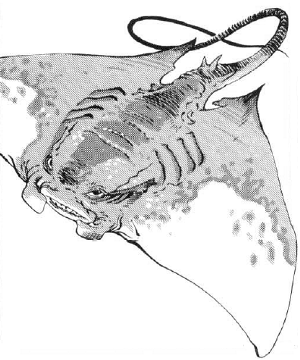

FREQUENCY: Very rare ([Cold
Wilderness Mountains], [Cold Wilderness Forest], [Cold Wilderness Swamp])
FREQUENCY: Very rare ([Temperate Wilderness Mountains],
[Temperate Wilderness Forest], [Temperate Wilderness Swamp])
FREQUENCY: Very rare ([Tropical
Wilderness Mountains], [Tropical Wilderness Forest], [Tropical Wilderness
Swamp])
FREQUENCY: Very rare
([Dungeon Level III])
NO. APPEARING: 1-3
ARMOR CLASS: 9
MOVE: 18" (MC: C)
HIT DICE: 1+1 <(wings)>
% IN LAIR: Nil
TREASURE TYPE: Nil
NO. OF ATTACKS: 1 ~18
DAMAGE/ATTACK: Special - see below
SPECIAL ATTACKS: Nil
SPECIAL DEFENSES: Nil
MAGIC RESISTANCE: Standard
INTELLIGENCE: Animal
ALIGNMENT: Neutral evil
SIZE: S
LEVEL/X.P. VALUE: III | 65 + 2
SAVES: 14.15.16.17.17
This flying creature bears a close resemblance to the
marine ray, with
a flat body about 3' long (and nearly as wide) and a
4' long thin whiplike tail.
The mantari (singular && plural) usually preys
on giant rats and
the like for food, but it is normally (85%) aggressive
when encountering
other creatures and humans.
It flies with its tail held
vertically downwards, but when attacking - diving onto
its victim
from a height of 10-12' above ground -- the tail assumes
a forward pointing
acute angle with the body.
It strikes solely by whipping a victim with its tail.
The sting in the tip
of the tail is not poisonous, but acts on the victim's
nervous system.
The number of HP of damage inflicted by a hit is equal
to the
difference between 19 and the victim's constitution (so
a victim with
constitution 12 would take 7 hit points of damage). No
saving throw
is permitted against the effects of the sting.
Furthermore, if the same victim is hit in two successive
melee rounds,
the damage inflicted by the second hit is four times
normal. There is
no additional damage bonus for the third or subsequent
successive
hit on the same victim - each counts as four times normal.
The mantari is found in most types of locale, though its
preferred
haunts are dirty dungeon chambers where its prey abounds.
For purposes
of aerial combat it is manoeuvrability class C.
by David Wormell